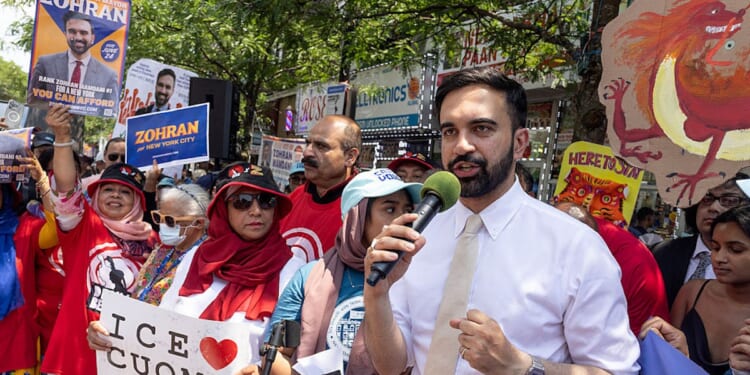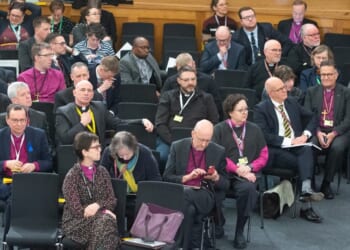She called him her son.
In Queens, campaign posters showed Zohran Mamdani grinning between a circle of “Bangladeshi aunties” — women who said they were turning out every neighbor they knew. They knocked doors, made phone calls, and spoke of the mayoral nominee as one of their own. But behind those family photos lay something else entirely.
The organizer leading those “aunties,” Kazi Fouzia, was also a longtime collaborator of Bangladeshi revolutionary figures and vocal proponent of Islamist-Maoist ideals, according to a report published ahead of the election in the New York Post.
The report reveals that what appeared to be organic neighborhood enthusiasm was, in fact, a coordinated mobilization routed through American nonprofits and foreign-aligned networks. It was a carefully orchestrated campaign, largely shaped from abroad.
At the center of this campaign stood Zohran Mamdani, a candidate whose charisma, polish, and digital fluency gave his movement the sheen of an authentic urban renaissance. The campaign’s marketing brilliance made it appear spontaneous, even inevitable — a national phenomenon born from grassroots energy.
Yet over the past year, three forces surreptitiously converged beneath the surface of the Mamdani campaign: foreign money, foreign propaganda, and foreign revolutionary ideology. A fleet of activist American nonprofits became a delivery system for foreign influence. Authoritarian regimes weaponized information platforms against American voters in a global laboratory of hidden persuasion.
Independent analyses show that networks manipulated engagement to summon foreign audiences to Mamdani on Instagram. By the end of his campaign, fewer than 50% of his online engagements from viral posts came from American users — a complete reversal from the clear domestic majority at the start.
On TikTok, content favorable to Mamdani and hostile to independent candidate and former New York Governor Andrew Cuomo surged 55% beyond organic reach. These are not abstract concerns. They are measurable distortions of civic reality across American digital networks made to masquerade as public life.
On the ground, the pattern was identical. The networks that secured Mamdani’s victory were not organic immigrant coalitions but extensions of foreign political movements. DRUM and its affiliate, DRUM Beats, claimed credit for mobilizing 150,000 South Asian and Indo-Caribbean voters — a 13% surge in Bangladeshi precincts and 11% among Pakistanis, with nearly half of all registered Bangladeshis voting.
Five leading organizers were linked to the Haqooq-e-Khalq Party, a Pakistani socialist party modeled after the “revolutions in Cuba and China” that collaborates with numerous entities backed by Neville Roy Singham. Independently, DRUM and DRUM Beats have also worked closely with Singham’s beneficiaries over the years. What looked like grassroots turnout was a foreign-aligned political operation routed through American nonprofits.
Singham is a billionaire now living in Shanghai and long identified by the New York Times and NCRI as a CCP asset for foreign influence. His flagship nonprofit, The People’s Forum, bankrolled with more than $20 million in Singham-linked funding, is currently under investigation by the House Ways and Means Committee for alleged foreign-agent activity and misuse of tax-exempt status.
The Forum became Mamdani’s unofficial campaign hub — hosting his rallies and strategy sessions, supplying organizers and media staff, and aligning its messaging with his own. Many of his core campaigners emerged from its activist network. Within this ecosystem, Singham’s niece, Alicia Singham Goodwin, launched Jews for Zohran, coordinating with Forum affiliates to shield the campaign from criticism and shore up a crucial constituency. Through this nexus – financed in Shanghai and operational in Manhattan — a CCP-aligned financier provided Mamdani with infrastructure, personnel, and ideological cover.
In the vacuum of American ideals, foreign powers found opportunity. They studied our divisions, learned our moral reflexes, and spoke the language of our disillusionment better than we could ourselves. The Mamdani campaign was the result. They learned that our nonprofits could be weaponized, our technology repurposed, and our compassion exploited as a tool for control. Through the Mamdani campaign, Marxist ideologues, Islamist movements, and CCP proxies built in New York an unparalleled infrastructures — an operating system for influence running quietly inside the American experiment.
And if they can make it here, they can make it anywhere.
The Network Contagion Research Institute (NCRI) is a nonpartisan research institute leading the field of cybersocial science a discipline that studies how technology, psychology, and society interact in the age of algorithmic influence.
The views expressed in this piece are those of the author and do not necessarily represent those of The Daily Wire.
















